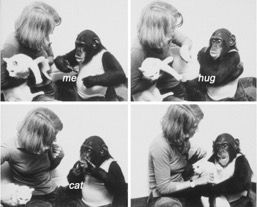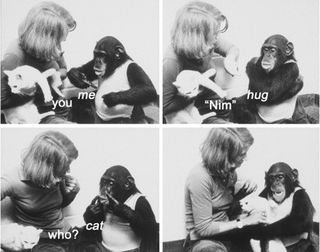Cognition
Why Chimpanzees Can't Learn Language: 1
My rollercoaster experience trying to teach a chimp sign language.
Posted October 2, 2019 Reviewed by Devon Frye
Forty years ago, I published an article, "Can a Chimpanzee Create a Sentence?" My answer was, definitively, "No." At the time, that conclusion was controversial. It was also headline news because other psychologists had claimed that chimpanzees did, in fact, have some linguistic ability.
Why were I and other psychologists concerned about the linguistic abilities of a chimpanzee? The reason was very simple. Following B. F. Skinner's lead, behaviorists thought that human's use of language could be explained as conditioned behavior. I was one of those behaviorists. If Skinner were right, why not condition our most intelligent living ancestor to learn language?
Noam Chomsky challenged that view and argued that language was uniquely human. Evidence to the contrary would be significant because it would question Darwin’s view that language, like all other intellectual abilities, evolved. If language didn’t evolve, by what other means did it appear?
Attempts to teach chimpanzees to use spoken language all faced the same problem: a chimpanzee's poorly developed articulatory apparatus. Chimpanzees are unable to produce the sounds (phonemes) that comprise human language. (In this blog I will only have room to describe attempts to teach American Sign Language, or ASL, a gestural language used by hundreds of thousands of deaf people. As I will explain in my next blog, however, my conclusions about a chimpanzee's inability to learn ASL also apply to all other attempts to teach animals to use language.)
On my project, I worked with an infant male chimpanzee I named Nim Chimpsky. He was raised in a New York townhouse by a family who knew sign language and was also taught to sign by volunteers. Nim learned his first sign, drink, when he was four months old.

During the next three and a half years, he had learned 127 other signs. Most surprising was his “spontaneous” ability to combine signs into simple sentences. For example, in the photos shown below, Nim is signing hug cat in order to play with a cat.
That and other combinations that Nim produced were the basis of the article I submitted to Science, in which I claimed that a chimpanzee could create a sentence. As evidence, I included the above photos. But a shocking discovery led me to withdraw the paper while it was under review. While observing slow-motion videotapes of Nim interacting with his teachers. I noticed that most of his signs were prompted by his teachers.
When I observed Nim signing, I realized that I was looking at him through a self-imposed telephoto lens. That was also true of his teachers and of a review panel from NIH led by an interpreter of ASL. Because we thought we were observing a chimpanzee who was making history by using sign language, our eyes were riveted upon Nim to the exclusion of everything else.
What happens when the view is changed from telephoto to wide-angle? Consider the same photos in which the teacher’s signs are identified.

In the upper left-hand photo, the teacher signs you, in response to which Nim signs me. In the upper right-hand photo, the teacher is about to make Nim’s name sign, which Nim would make by scratching his forehead with the letter n. Nim crossed her up by signing hug, a "wildcard" sign that was often used to obtain a reward. In the lower left-hand panel the teacher signed who? before Nim signed cat.
In this, and in hundreds of other instances, Nim’s teachers anticipated what he might sign and made those signs a fraction of a second before he did. I documented those interactions, and others I found in films of a chimpanzee and their trainers, e.g., Washoe and her trainer Beatrice Gardner, and submitted a new article to Science. That was the article to which I referred in the opening sentence of this blog.
At this point, the reader may well wonder: Why did Nim sign? After years of experience of observing Nim and other chimpanzees who learned to sign, the only answer I know is to obtain a reward.
Consider what happens during a typical training session. The teacher has access to many rewards—for example, an item of food, a drink, a hug, a toy, a picture book, an opportunity to play with a cat, and so on. Nim typically tries to obtain such rewards without signing. When he doesn't succeed, the teacher asks him to sign. On such occasions, Nim would often hold out his hands as an invitation for the teacher to mold them into the required sign. At other times, Nim would imitate the teacher’s sign.
The problem with those teaching methods is that a physical reward is the only motivation for Nim to sign. That’s in stark contrast to the experience of infants who begin to produce words at the beginning of their second year. Typically, those words are the names of objects to which that the infant and a parent jointly attend.
If infants’ utterances were limited to demanding rewards, they would never learn language. The absence of the ability to name objects or events seems to be totally lacking in chimpanzees and is the best explanation I know of their inability to learn language.
Returning to the question posed by my Science article, Chomsky was right that chimpanzees can't create a sentence. But he was right for the wrong reason. It's not that chimpanzees can't learn grammar. They can't even learn words. Before an infant produces the first words, typically when she's 12 months old, she experiences two special non-verbal relations with her parents that are uniquely human. Those experiences, which are the royal road to language, will be the topic of a future blog.
Facebook/LinkedIn Image Credit: Thorsten Spoerlein/Shutterstock
References
Terrace, H., et al. (1979). "Can an ape create a sentence?" Science 206: 891-902.




